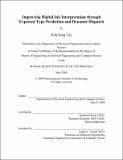| dc.contributor.advisor | Kimberle Koile. | en_US |
| dc.contributor.author | Tay, Kah Seng | en_US |
| dc.contributor.other | Massachusetts Institute of Technology. Dept. of Electrical Engineering and Computer Science. | en_US |
| dc.date.accessioned | 2009-08-25T17:59:27Z | |
| dc.date.available | 2009-08-25T17:59:27Z | |
| dc.date.copyright | 2008 | en_US |
| dc.date.issued | 2008 | en_US |
| dc.identifier.uri | http://hdl.handle.net/1721.1/46364 | |
| dc.description | Thesis (M. Eng.)--Massachusetts Institute of Technology, Dept. of Electrical Engineering and Computer Science, 2008. | en_US |
| dc.description | This electronic version was submitted by the student author. The certified thesis is available in the Institute Archives and Special Collections. | en_US |
| dc.description | Includes bibliographical references (p. 67-70). | en_US |
| dc.description.abstract | Interpretation accuracy of current applications dependent on interpretation of handwritten "digital ink" can be improved by providing contextual information about an ink sample's expected type. This expected type, however, has to be known or provided a priori, and poses several challenges if unknown or ambiguous. We have developed a novel approach that uses a classic machine learning technique to predict this expected type from an ink sample. By extracting many relevant features from the ink, and performing generic dimensionality reduction, we can obtain a minimum prediction accuracy of 89% for experiments involving up to five different expected types. With this approach, we can create a "dynamic dispatch interpreter" by biasing interpretation differently according to the predicted expected types of the ink samples. When evaluated in the domain of introductory computer science, our interpreter achieves high interpretation accuracy (87%), an improvement from Microsoft's default interpreter (62%), and comparable with other previous interpreters (87-89%), which, unlike ours, require additional expected type information for each ink sample. | en_US |
| dc.description.statementofresponsibility | by Kah Seng Tay. | en_US |
| dc.format.extent | 91 p. | en_US |
| dc.language.iso | eng | en_US |
| dc.publisher | Massachusetts Institute of Technology | en_US |
| dc.rights | M.I.T. theses are protected by
copyright. They may be viewed from this source for any purpose, but
reproduction or distribution in any format is prohibited without written
permission. See provided URL for inquiries about permission. | en_US |
| dc.rights.uri | http://dspace.mit.edu/handle/1721.1/7582 | en_US |
| dc.subject | Electrical Engineering and Computer Science. | en_US |
| dc.title | Improving digital ink interpretation through expected type prediction and dynamic dispatch | en_US |
| dc.type | Thesis | en_US |
| dc.description.degree | M.Eng. | en_US |
| dc.contributor.department | Massachusetts Institute of Technology. Department of Electrical Engineering and Computer Science | |
| dc.identifier.oclc | 406589835 | en_US |
